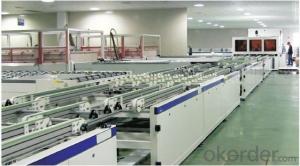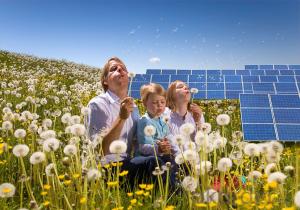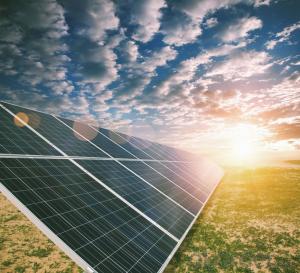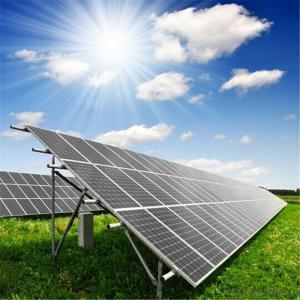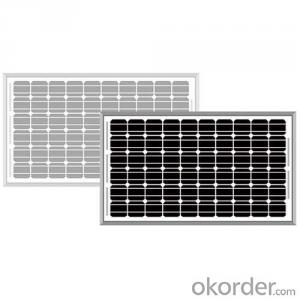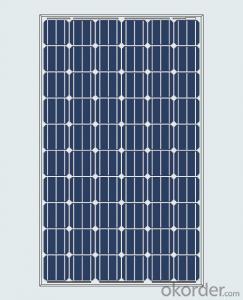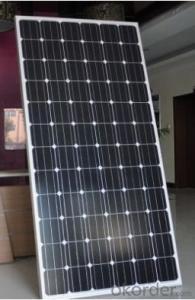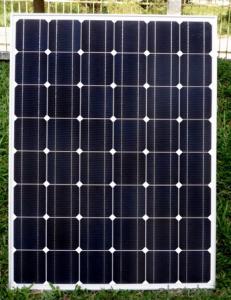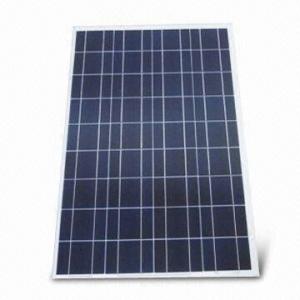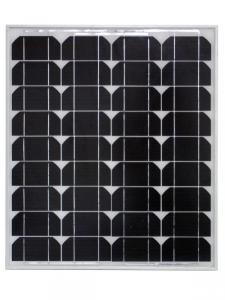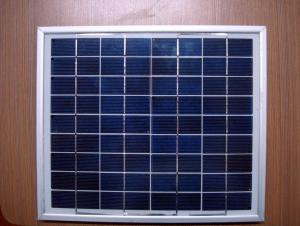Narrow High Efficiency 300W Monocrystalline Solar Module for Home Solar Power System
- Loading Port:
- China main port
- Payment Terms:
- TT OR LC
- Min Order Qty:
- 1 pc
- Supply Capability:
- 10000000 pc/month
OKorder Service Pledge
OKorder Financial Service
You Might Also Like
Quick Details
| Place of Origin: | Guangdong China (Mainland) | Brand Name: | Felicitysolar | Model Number: | FLS-M-300W |
| Material: | Monocrystalline Silicon | Size: | 1954*992*40mm | Max. Power: | 300w |
| weight: | 25kg | Warranty: | 5 years | Current max power: | 8.33A |
| Voltage max power: | 36.0V | Short cicuit current: | 9.58A | Open circit voltage: | 41.6V |
| Temperature range: | -40℃ -- +85℃ | OEM: | avaliable |
Packaging & Delivery
| Packaging Detail: | 2 pcs/ piece |
| Delivery Detail: | Whitin 18 days after recevie the deposit. |
Specifications
monocrystalline solar module
1.High efficiency,energy saving,use safe.
2.Easy handle,high quality,low price,good after service
Solar Module
SPECIFICATION |
Model No.:FL-P250 | |
Max.Power(±5%)[Pmax] | 300Wp |
Current Max.Power[lmp] | 8.33A |
Voltage Max.Power[Vmp] | 36.0V |
Short Circuit Current[Isc] | 9.58A |
Open Circuit Voltage[Voc] | 41.6V |
Max.System Voltage | 1000VDC |
Cell Technology | Polycrystalline |
Module dimension | 1954x992x40mm |
Weight | 25.0Kg |
All technical data at standard test condition:AM=1.5, E=1000W/m2℃
Produced in correspondence with international safety standards.
WARNING:HAZARDOUS ELECTRICITY!
CAN SHOCK,BURN OR CAUSE DEATH. Do not touch terminals
PRODUCT DISPLAY |
PRODUCT STRUCTURE |
1. glass
Its main role is to protect the power generation ( solar cells ) , there is a selection of light transmittance requirements : 1 ) must be high transmittance (typically 91% or more ) ; 2 ) super white steel processing.
2. EVA
For bonding glass and power generation fixed body ( such as cells ) , transparent EVA material directly affect the life of components exposed to the air EVA prone aging yellow , thus affecting the transmittance components , thus affecting in addition to generating the quality of the components itself, the quality EVA lamination process on the component manufacturers is also very large, such as EVA plastic viscosity of non-compliance , EVA and glass, back bonding strength is not enough, can cause premature aging EVA, the affected component life.
3. Solar cells
The main role is to generate electricity , the electricity is the main market mainstream film crystalline silicon solar cells , thin-film solar cells , both have their advantages and disadvantages . Crystalline silicon solar cells , the equipment costs are relatively low , but the high cost of consumption and cells , photoelectric conversion efficiency is high, the next generation in outdoor sunlight is more appropriate ; higher thin-film solar cells , the relative cost of equipment , but the cost of consumption and battery low, relatively low photoelectric conversion efficiency of crystalline silicon solar cells , but the effect is very good low-light , in the ordinary light can also generate electricity , such as solar calculator .
4. backplane
Sealing, insulation , water ( usually with TPT, TPE , etc. ) the material must be resistant to aging , component manufacturers generally have warranty for 25 years , tempered glass, aluminum is generally no problem , the key lies in whether the backplane and can meet the requirements of silica gel.
WORKING PRINCIPLE |
Solar panels solar power system is the core part of the solar system, the highest part of the value . Its role is to convert solar energy into electrical energy stored in batteries or sent to , or promote the work load .
When the p -type semiconductor and n -type semiconductor when combined together into a tight , at the interface between the p-n junction is formed . When the cell is irradiated with sun light in the p-n junction is formed on both sides of the positive and negative charge accumulation , the photovoltaic generation of the formation of the internal electric field , which is " photovoltaic effect ." Theoretically, this time, if the electric field on both sides of the built-in and lead-out electrodes connected to an appropriate load , the current will be formed , will be obtained on the load power . The solar cell module is the use of electronics to achieve characteristics of the semiconductor material of solid P-V conversion means . Which is the photovoltaic solar battery works .
PRODUCT ADVANTAGE |
Advantages
1.High power, high efficiency
2. Long lifespan, energy saving, environmental-friendly
3. Advanced technology, exquisite workmanship
4. Easy installation, free maintenance
FAQ |
[Q:] what is the solar module? [A:] solar panels by cells, components of the border, toughened glass, packaging materials and the junction box and so on, a piece of board can use sunlight to power generation.
[Q:] what is the solar cell (plate)? [A:] solar cell (plate) is a use of solar power photoelectric semiconductor wafer.
[Q:] types of solar panels? [A:] Solar panel common mainly single crystal, polycrystalline,amorphous three materials. Among them, the best single crystal,high efficiency, the price is high; polycrystalline low efficiency of 2%,the price almost, this two kinds of life for more than 25 years;amorphous low efficiency, short life, but the price is cheaper. From the cost point of view, the highest or single crystal.
[Q:] Standard test conditions of solar cells [A:] Power solar panels is in standard condition: temperature of 25 degrees, AM1.5, 1000W/M2 under test. General use WP (WP) said,you can also use the W (W) said. Power test in this standard is called the nominal power.
[Q:] solar panel is how to work? [A:] solar panels can produce current in a certain intensity ofillumination, the electrical appliance can be used. The premise is the unit of current time than electrical consumption. In practical application, the direct use of the situation is less. Generally the whole system to use.
- Q: Can solar panels be installed on vehicles?
- Yes, solar panels can be installed on vehicles. Many electric vehicles and some hybrid vehicles come equipped with solar panels to help charge their batteries. Additionally, solar panels can be installed on the roofs of various types of vehicles, such as RVs, boats, and campers, to generate electricity for powering onboard appliances and systems.
- Q: Can solar panels be used to power a factory?
- Yes, solar panels can be used to power a factory. By installing a large number of solar panels on the factory's roof or in nearby open spaces, the generated solar energy can be harnessed and converted into electricity to meet the power requirements of the factory. This can help reduce the dependency on traditional grid electricity and also contribute towards a more sustainable and environmentally friendly operation of the factory.
- Q: Can solar panels be installed on a telecommunications tower or antenna?
- Yes, solar panels can be installed on a telecommunications tower or antenna. In fact, many telecom companies are increasingly adopting this practice to power their equipment and reduce reliance on grid electricity. Solar panels can be mounted on the tower structure or integrated into the antenna design to generate renewable energy and ensure continuous power supply for telecommunication operations.
- Q: Can solar panels be installed on government buildings?
- Yes, solar panels can be installed on government buildings. In fact, many governments around the world have already embraced solar energy and installed photovoltaic systems on their buildings as part of their commitment to renewable energy and sustainability. This helps reduce the carbon footprint of government operations and serves as a positive example for the community.
- Q: Can solar panels be installed on a government building?
- Yes, solar panels can be installed on a government building. In fact, many government buildings have already implemented solar energy systems to reduce their carbon footprint and lower energy costs.
- Q: Can solar panels be installed on a sloped roof?
- Yes, solar panels can be installed on a sloped roof. In fact, sloped roofs are quite common for solar panel installations. The angle and direction of the slope can affect the efficiency of the panels, so it is important to consider the roof's orientation and shading when planning the installation.
- Q: Hi! I bought a Coleman 2 vdc cooler that pulls 9 amps. What size solar panel and amp-hour battery do I need? I only open it 3 times a day. It will hold about 3 gals of milk.
- If it pulls 9 amps continuously, that's 08 watts/hour or about 2.5 kwh/day. If it only pulls half that (does it cycle?) it's about .2 kwh/day. You only want to drain a lead-acid battery 50% or so, so you'll want a 5 or 2.5 kwh battery pack. A typical setup for the 5 kwh would be two L-6 batteries in series, and for the 2.5 kwh you could use 2 T-05 batteries in series. This does not account for days of cloud. If you regularly have cloudy days, size the battery pack for two or three days of use with no input (2-3 x the sizes given above). To charge them, you typically want panels that will charge your battery at least 5% of its capacity per hour (C/20). For 2 volt nominal panels that's 0 amps for the T-05 or 20 amps for the L-6 batteries. It's good to have more than that for battery life (it cuts down on what's called stratification), so you'll want probably 50-200 watts of panels for the T-05 and 300-400 for the L-6. You'll also need a charge controller. Peltier coolers are very inefficient. You'll save money by using a regular mini-fridge and an inverter. Most mini-fridges only draw 50 watts or so, so you're talking 600 watt-hours for a 50% duty cycle. This means two T-05 batteries will give you two days of use and you'll only need 20-50 watts of panel. DK
- Q: Can solar panels be installed in areas with high levels of air pollution?
- Yes, solar panels can be installed in areas with high levels of air pollution. Although air pollution may slightly reduce the efficiency of solar panels, they can still generate electricity even in polluted environments. Regular maintenance and cleaning of the panels can help mitigate the impact of air pollution on their performance. Additionally, using advanced technologies and materials in the design of solar panels can also enhance their resilience to air pollution.
- Q: Can solar panels be used to power a sports stadium?
- Yes, solar panels can be used to power a sports stadium. By installing a sufficient number of solar panels on the roof or surrounding areas of the stadium, the generated electricity can be used to power various facilities such as lighting, scoreboards, sound systems, and even some of the equipment needed for the sporting events. Additionally, excess energy can be stored in batteries or fed back into the grid, making it a sustainable and cost-effective solution for powering a sports stadium.
- Q: I need to know how Solar panels work please help me!! Also, if you know any other additional important information about Solar Energy in General please tell me, Thanks.
- The most important parts of a solar cell are the semiconductor layers, this is where the electron current is created. There are a number of different materials available for making these semiconducting layers, and each has benefits and drawbacks. Unfortunately, there is no one ideal material for all types of cells and applications. In addition to the semiconducting materials, solar cells consist of a top metallic grid or other electrical contact to collect electrons from the semiconductor and transfer them to the external load, and a back contact layer to complete the electrical circuit. Then, on top of the complete cell is typically a glass cover or other type of transparent encapsulant to seal the cell and keep weather out, and a antireflective coating to keep the cell from reflecting the light back away from the cell. A typical solar cell consists of a cover glass, a anti-reflective layer, a front contact to allow the electrons to enter a circuit and a back contact to allow them to complete the circuit, and the semiconductor layers where the electrons begin to complete there voyages! The solar panels, in order to generate power, are using the method of screen-printing, a technique developed for printing fabrics, paper and to produce plastic, glass and metal solar cells. The basic materials of a photovoltaic cell (solar cell) are inexpensive. The homemade solar cells have about /4 of the efficiency of commercial silicon solar cells, which turn 0-20 per cent of light energy into electricity. But, being cheap to produce, they can make up the loss in quantity what they lack in quality.
Send your message to us
Narrow High Efficiency 300W Monocrystalline Solar Module for Home Solar Power System
- Loading Port:
- China main port
- Payment Terms:
- TT OR LC
- Min Order Qty:
- 1 pc
- Supply Capability:
- 10000000 pc/month
OKorder Service Pledge
OKorder Financial Service
Similar products
Hot products
Hot Searches
Related keywords
